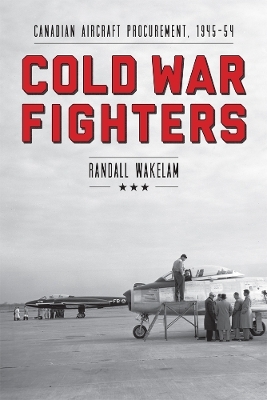
Cold War Fighters
Canadian Aircraft Procurement, 1945-54
Seiten
2011
University of British Columbia Press (Verlag)
978-0-7748-2148-3 (ISBN)
University of British Columbia Press (Verlag)
978-0-7748-2148-3 (ISBN)
- Titel z.Zt. nicht lieferbar
- Versandkostenfrei
- Auch auf Rechnung
- Artikel merken
In detailing the complexities of buying fighter aircrafts for the RCAF in the early years of the Cold War, Wakelam also sheds light on contemporary procurement issues.
The cancellation of the CF-105 Arrow in 1959 holds such a grip on the imagination of Canadians that earlier developments in defence procurement remain in the shadows.
Randall Wakelam corrects this oversight – and offers fresh insight into the AVRO saga and contemporary procurement issues – by detailing the complexities Canada’s air force faced in buying fighter aircraft and by showing how the RCAF grew by leaps and bounds. Wakelam shows that cabinet members, chiefs of staff, and air marshals were forced to negotiate competing pressures to arm the air force, please allies, and save money. Their decisions resulted in the CF-100 Canuck and the F-86 Sabre, Canada’s front-line defensive aircraft in the coldest years of the Cold War. Although historians assume that the Arrow arrived on the heels of these successes, Wakelam reveals that neither the air force nor the government believed AVRO could manufacture even the CF-100 on budget.
The cancellation of the CF-105 Arrow in 1959 holds such a grip on the imagination of Canadians that earlier developments in defence procurement remain in the shadows.
Randall Wakelam corrects this oversight – and offers fresh insight into the AVRO saga and contemporary procurement issues – by detailing the complexities Canada’s air force faced in buying fighter aircraft and by showing how the RCAF grew by leaps and bounds. Wakelam shows that cabinet members, chiefs of staff, and air marshals were forced to negotiate competing pressures to arm the air force, please allies, and save money. Their decisions resulted in the CF-100 Canuck and the F-86 Sabre, Canada’s front-line defensive aircraft in the coldest years of the Cold War. Although historians assume that the Arrow arrived on the heels of these successes, Wakelam reveals that neither the air force nor the government believed AVRO could manufacture even the CF-100 on budget.
Colonel (ret’d) Randall Wakelam teaches military history and leadership at the Royal Military College of Canada and is author of The Science of Bombing: Operational Research in RAF Bomber Command. A pilot in his service career, he also worked in aircraft procurement.
1 An Air-Minded Middle Power
2 Planning for Peace
3 International and Industrial Alliances
4 Caught Flat-Footed
5 Facing the Threat in Earnest
6 And So to War
7 Juggling Numbers
8 Putting Rubber on the Ramp
9 Growing Needs, Growing Concerns
10 Fact and Fancy
Appendix A: Royal Canadian Air Force Headquarters Organization Chart, c. 1947
Appendix B: Department of Defence Production Aircraft Delivery Statistics, 1951-54
Notes
Bibliography
Index
| Reihe/Serie | Studies in Canadian Military History |
|---|---|
| Zusatzinfo | 16 b&w illustrations, 8 tables |
| Verlagsort | Vancouver |
| Sprache | englisch |
| Maße | 152 x 229 mm |
| Gewicht | 440 g |
| Themenwelt | Natur / Technik ► Fahrzeuge / Flugzeuge / Schiffe ► Militärfahrzeuge / -flugzeuge / -schiffe |
| Geschichte ► Allgemeine Geschichte ► Zeitgeschichte | |
| Geisteswissenschaften ► Geschichte ► Regional- / Ländergeschichte | |
| Sozialwissenschaften ► Politik / Verwaltung | |
| ISBN-10 | 0-7748-2148-5 / 0774821485 |
| ISBN-13 | 978-0-7748-2148-3 / 9780774821483 |
| Zustand | Neuware |
| Haben Sie eine Frage zum Produkt? |
Mehr entdecken
aus dem Bereich
aus dem Bereich
von der Machtergreifung bis zur Gründung der Vereinten Nationen
Buch | Softcover (2023)
Motorbuch Verlag
CHF 38,90


